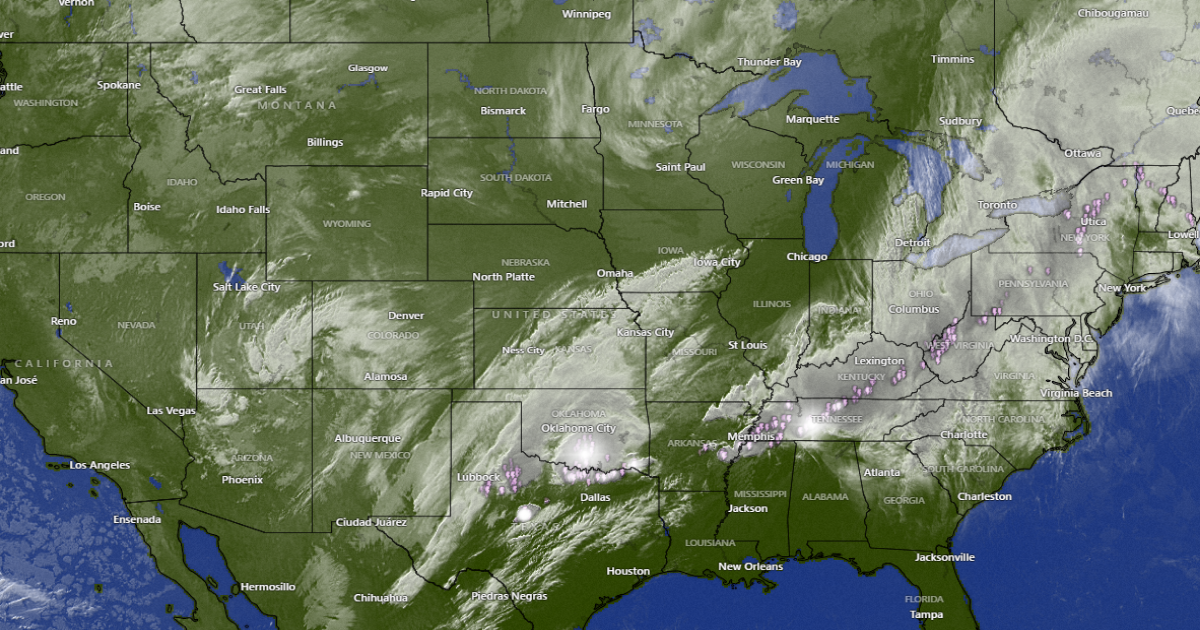A sprawling and violent weather system swept across the South and Midwest into Thursday morning, spawning multiple tornadoes, downing power lines, and leaving at least one person dead in Missouri as emergency crews scrambled to respond to widespread damage.
The severe outbreak prompted rare tornado emergencies, crippled infrastructure, and threatened tens of millions with more catastrophic weather in the days ahead.

Storms shown across the US on Thursday morning. Storms shown across the US on Thursday morning. Windy.com
As darkness fell across the central U.S., communities from Arkansas to Indiana were left reeling from the onslaught. Homes were torn apart, trees uprooted, and entire neighborhoods plunged into darkness. The National Weather Service (NWS) described the unfolding disaster as “a once-in-a-generation to once-in-a-lifetime” event, warning that the worst may still be ahead.
“It’s definitely going to be a really horrible situation here come sunrise in the morning in those areas,” Chelly Amin, an NWS meteorologist, said late Wednesday.
Extreme Weather Warnings: Live Tracker Map
In Blytheville, Arkansas, the NWS took the unusual step of issuing a tornado emergency—the highest level of alert—after radar detected debris being thrown 25,000 feet into the air. That same system lashed surrounding counties, leaving homes shredded and residents injured.
Rain, Thunder Warnings: Live Tracker Map
In Missouri, a person was killed as the storms pushed through the southeastern part of the state, according to KFVS-TV. Meanwhile, in Indiana, part of a warehouse collapsed in Brownsburg, trapping at least one person. Five semi-trucks were overturned by powerful winds on Interstate 65 near Lowell, underscoring the sheer force of the storm system.
Kentucky also felt the fury. A suspected tornado tore through Jeffersontown near Louisville, sending debris from a nearby church flying. Four people were injured, including one in critical condition.
By Wednesday night, more than 270,000 customers across six states—including Arkansas, Missouri, Kentucky, Illinois, Tennessee, and Indiana—were without power, according to PowerOutage.us. In Indiana alone, more than 182,000 lost electricity as storms surged through.
Wind Warnings: Live Tracker Map
And it wasn’t just tornadoes. Flash flooding became a growing concern across the Ohio and Mississippi Valleys. Streets in Indianapolis were submerged, with floodwaters creeping up to car windows. Fortunately, no occupants were inside the vehicles at the time.
“I don’t recall ever seeing one like this, and I’ve been here 30 years,” said meteorologist Mark Rose with the NWS in Nashville.
Wind Accumulation: Live Tracker Map
The Storm Prediction Center placed 2.5 million people under a rare “high risk” designation—a level only used in the most dangerous conditions. This zone spanned from Memphis, Tennessee, through northeast Arkansas, the southeast corner of Missouri, and into western Kentucky and southern Illinois.
Officials warned that “multiple long-track EF3+ tornadoes” were likely, capable of staying on the ground for miles with devastating intensity.
Thunderstorm Warnings: Live Tracker Map
Even cities outside the highest-risk area weren’t spared. Chicago, St. Louis, and Nashville all faced elevated threats, with forecasters calling for vigilance through the weekend.
Weather Warnings: Live Tracker Map
As storms moved eastward, flash flooding posed a growing risk, especially in regions expecting repeated rounds of rain. Parts of Texas, the lower Mississippi Valley, and the Ohio Valley were forecast to receive as much as 15 inches of rain by Saturday.
In Michigan, meanwhile, crews worked to restore power from a weekend ice storm that continued to wreak havoc. More than 122,000 customers remained without electricity. The Mackinac Bridge was shut down for a third day due to massive ice chunks falling from cables and towers.
A Long Road Ahead
With storms still moving through and floodwaters rising, emergency responders and meteorologists alike warned that the coming days would test the resilience of communities across the central U.S.
